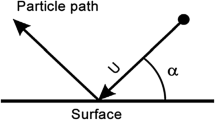Abstract
The multifactorial erosion was conducted in this paper to test the compressor impeller material FV520B using high-speed gas-solid two phase flow erosion tester and surface morphology analysis method. Based on the particle motion and collision energy equation as well as regression analysis of multi-factor orthogonal experiment, a phenomenological erosion depth model which captures the effects of impact velocity, angle and particle size, has been developed. The model includes removal of material due to both deformation damage and micro-cutting. Results show that the peak of experiment depth and the maximum calculated depth all appeared at near 45°, rather than near 24° where the maximum erosion rate appeared. Comparing the calculated values and the results of each single factor experiment, the errors are within 15%. The predictions of the simplified version of the model were in good agreement with the results of single factor experiments. Also, the reliability of the assessment formula was verified to assess the impeller erosion life, which indicated that this calculation model could be used to estimate the erosion depth of compressor impeller material FV520B.
Similar content being viewed by others
References
Utamura, M., Fukuda, T., and Aritomi, M., “Aerodynamic Characteristics of a Centrifugal Compressor Working in Supercritical Carbon Dioxide,” Energy Procedia, Vol. 14, pp. 1149–1155, 2012.
Dowson, P., Walker, M. S., and Watson, A. P., “Development of Abradable and Rub-Tolerant Seal Materials for Application in Centrifugal Compressors and Steam Turbines,” Sealing Technology, Vol. 2004, No. 12, pp. 5–10, 2004.
Yoon, W. N., Kang, M. S., Jung, N. K., Kim, J. S., and Choi, B.-H., “Failure Analysis of the Defect-Induced Blade Damage of a Compressor in the Gas Turbine of a Cogeneration Plant,” Int. J. Precis. Eng. Manuf., Vol. 13, No. 5, pp. 717–722, 2012.
Kawagishi, H., Kawassaki, S., and Ikeda, K., “Protective Design and Boride Coating Against Sol Id Particle Erosion of First Stage Turbine Nozzles,” Advances in Steam Turbine Technology for Power Generation, Vol. 1990, No. 10, pp. 23–29, 1990.
Parsi, M., Najmi, K., Najafifard, F., Hassani, S., McLaury, B. S., et al., “A Comprehensive Review of Solid Particle Erosion Modeling for Oil and Gas Wells and Pipelines Applications,” Journal of Natural Gas Science and Engineering, Vol. 21, pp. 850–873, 2014.
Mbabazi, J., Sheer, T., and Shandu, R., “A Model to Predict Erosion on Mild Steel Surfaces Impacted by Boiler Fly Ash Particles,” Wear, Vol. 257, No. 5, pp. 612–624, 2004.
Duan, X.-M., Jia, D.-C., Zhou, Y., Yang, Z.-H., Wang, Y.-J., et al., Mechanical Properties and Plasma Erosion Resistance of BNp/ Al2O3-SiO2 Composite Ceramics, Journal of Central South University, Vol. 20, No. 6, pp. 1462–1468, 2013.
Kim, W.-B., Nam, E., Min, B.-K., Choi, D.-S., Je, T.-J., et al., “Material Removal of Glass by Magnetorheological Fluid Jet,” Int. J. Precis. Eng. Manuf., Vol. 16, No. 4, pp. 629–637, 2015.
Hu, Y., Kang, Y., Wang, X.-C., Li, X.-H., Long, X.-P., et al., “Mechanism and Experimental Investigation of Ultra High Pressure Water Jet on Rubber Cutting,” Int. J. Precis. Eng. Manuf., Vol. 15, No. 9, pp. 1973–1978, 2014.
Dornfeld, D. A., “Moving towards Green and Sustainable Manufacturing,” Int. J. Precis. Eng. Manuf.-Green Tech., Vol. 1, No. 1, pp. 63–66, 2014.
Bitter, J. G. A., “A Study of Erosion Phenomena,” Wear, Vol. 6, No. 1, pp. 5–21, 1963.
Hutchings, I. M., “A Model for the Erosion of Metals by Spherical Particles at Normal Incidence,” Wear, Vol. 70, No. 3, pp. 269–281, 1981.
Wang, S.-S., Liu, G.-W., Mao, J.-R., Guo, H., Ma, X., et al., “Modeling Experimental System for Solid Particle Erosion on the Steam Turbine Nozzle Blades and Measuring Methods, Proc. of the Chinese Society of Electrical Engineering,” Vol. 27, No. 11, pp. 103–108, 2007.
Cen, K. F., “The Theory and Computation of Gas-Solid Multiphase Flow in Engineering,” Zhejiang: Zhejiang University Press, pp. 303–375, 1990.
Li, Z., “Similarity and Modeling (Theory and Application),” National Defence Industry Press, 1982.
Lu, J. H. and Ling, Z. G., “Numerical Analysis and Experiment Investigation of Blade Erosion in Particle-Laden Gas Turbine, Power Engineering,” Vol. 22, No. 4, pp. 1858–1862, 2002.
Finnie, I. and McFadden, D. H., “On the Velocity Dependence of the Erosion of Ductile Metals by Solid Particles at Low Angles of Incidence, Wear,” Vol. 48, No. 1, pp. 181–190, 1978.
Hutchings, I. M., “Corrosion/Erosion of Coal Conversion System Materials,” Proc. of the Corrosion-Erosion of Coal Conversion System Materials, p. 393, 1979.
Brach, R. M., “Impact Dynamics with Applications to Solid Particle Erosion,” International Journal of Impact Engineering, Vol. 7, No. 1, pp. 37–53, 1988.
Gu, Y., Chen, C. H., Chen, J. J., and Ye, X. C., “Research on Wear Behavior of 26Cr12Ni and 25Cr20Ni Stainless Steel,” Hot Working Technology, Vol. 43, No. 8, pp. 84–86, 2014.
Yìldìzlì, K., Karamìs, M. B., and Nair, F., “Erosion Mechanisms of Nodular and Gray Cast Irons at Different Impact Angles,” Wear, Vol. 261, No. 5–6, pp. 622–633, 2006.
Du, Y. P., Zhao, H., Yang, C. H., Zhang Y., and Hu, R., “Catalyst Fines Behavior among FCC Flue Gas Turbine Blade Rows-Erosion and Fouling on Blades,” Chemical Engineering, Vol. 40, No. 9, pp. 52–55, 2012.
Author information
Authors and Affiliations
Corresponding author
Rights and permissions
About this article
Cite this article
Liu, ZW., Li, JF., Jia, XJ. et al. Establishment and analysis of erosion depth model for impeller material FV520B. Int. J. of Precis. Eng. and Manuf.-Green Tech. 3, 27–34 (2016). https://doi.org/10.1007/s40684-016-0004-8
Received:
Revised:
Accepted:
Published:
Issue Date:
DOI: https://doi.org/10.1007/s40684-016-0004-8



